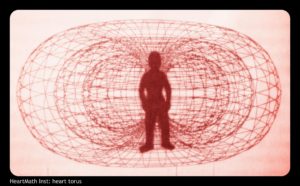
Boundaries. I love how the therapeutic community throws words like “boundaries” around, without a clear explanation. Before you read on, in fact, go ahead and test this (and for those of you who’ve had therapy, or at least read a multitude of self-help books, this should be especially fun). How would you describe boundaries? Are they:
- A concept of mental health determining, cognitively, what is appropriate and what is not.
- A “wall” that keeps out all those but whom you, very selectively, let in.
- A “wetsuit” that you can physically sense, that blocks energy.
- None of the above.
 Years ago, I went to a workshop given by a physician, Joseph Chilton Pearce, who believed he succeeded in identifying and tracking an energy field that originated in the heart, extending out then down, looping back up to the place of origin. He based these on computer measurements taken by HeartMath and the University of Utah. These initial findings might be validation for what our ancestors and current shamanic healers in more natural societies understand as an essential component of healing, that our energy is as real as our matter.
Years ago, I went to a workshop given by a physician, Joseph Chilton Pearce, who believed he succeeded in identifying and tracking an energy field that originated in the heart, extending out then down, looping back up to the place of origin. He based these on computer measurements taken by HeartMath and the University of Utah. These initial findings might be validation for what our ancestors and current shamanic healers in more natural societies understand as an essential component of healing, that our energy is as real as our matter.
An Experiment in Finding Your Boundaries
I know, you think that next I’ll be telling you to use this energy to manifest a red Jaguar. Relax, I’m just asking you to consider doing another experiment now, and see for yourself. You’ll need a friend for this: first, get seated and grounded, as you need to be able to sense your body to start with. Then have your friend sit next to you, but not too close. An arm’s length away is good. Close your eyes. Have him/her slowly bring their hand close enough to touch you, and say “stop” right before you think they’ll make contact. Can you sense? If you can, do you think the explanation is more than just becoming aware of body heat or of a change in the light your closed eyes can still experience?
What you might consider, in the question above, is “d.” The traditional concept of boundaries, as a wall against others, is actually anti-therapeutic in the long run. After all, aren’t we hoping for more satisfying relationships with others? How can that be, if our “healthy” response to anyone new starts with “no?” Whether you agree with the energy model or not, imagine at least that there is a field of some sort around you. When someone, known or unknown, comes in contact with this field, this territory within your boundaries, you become alert to this new influence. You pick up information on a subtle level, either energetically, or if you prefer, through a multitude of “tells”—demeanor, facial expression, scent, small nervous movements or rigidity—that indicate whether you want to draw this person in closer (which will not happen if all you’ve got working for you is a wall) or go into protective mode.
After all, as Robert Frost declared: “there is something in one that does not love a wall.”
Let Me Show You What I Mean
Below, there’s a brief video of a friend of mine, Margaret, and I doing a simple standing exercise, with me slowly approaching until she senses me–what we call the ‘alert’. At that point, I’ll back off, and we’ll discuss her experience. It is the ‘alert’ that is significant here, because it will be different for those with healthy systems than with traumatized ones.With healthy systems, what usually happens, about three feet out, is a heightened sense, a little awakening—not anxiety, but certainly increased awareness, which morphs into a pleasant sensation, or a contraction that indicates the urge to protect one’s self. In the traumatized system, however, the experience is quite different: either I would be able to walk all the way up to my friend without any change in her body, or at a much further distance than three feet, she would feel a rush of anxiety or another distressing sensation. Some of my clients have even stopped me before I’ve taken one step; just the thought of my moving towards them was enough for a powerfully protective response that was completely out of relation to the current “threat.” Moi, threatening?
Boundaries are a Body Thing
Overwhelming stress, particularly that experienced by the adult children of parents who are emotionally immature or personality disordered, deeply impacts our sense of personal territory. Do we have a right to territory? What does it take to keep myself safe within that territory? If I feel an alert, should I mention it, because I might hurt someone else’s feelings? Because for me, and in my experience, our boundaries physically mark the beginning of what constitutes “us,” they are not merely a concept, and in becoming more embodied, less dissociative, we are more able to feel physically when someone is crossing those boundaries and entering what we sense as our personal space.
When my clients move from a “wall” concept of boundaries, to one of selective osmosis, where we attract as much as we repel, if not more so, given the right indicators, we are much more capable of functioning in the world. It is exhausting having to charge up those defenses! It is not only wonderful to attract, it also allows for the warmth of community, the recognition of a future significant other, or even a good professional match. And this is why I love the “energy” model: the more you charge up your energy field the more capable you are of repelling that which does not appeal to you. Predators prey upon the weak. The more capable you are of attracting that which serves you. Friends are drawn to your light.